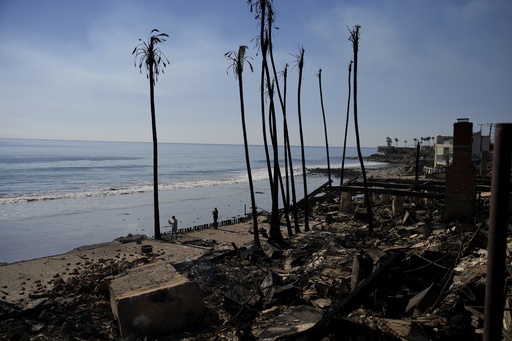LOS ANGELES — Efforts to enhance tree cover in Los Angeles, aimed at alleviating the impact of heat and air pollution, face serious challenges due to severe drought conditions, improper maintenance, and resistance from residents who dislike fallen leaves and sap. With the recent catastrophic fires, concerns grow regarding the state of their initiatives.
City arborists have documented significant damage, sharing “sobering” images of mature trees that have been uprooted by powerful winds, which also contributed to the spread of these fires, according to Bryan Vejar, the associate director of community forestry for TreePeople, an environmental organization dedicated to planting and tending to trees in the city. Other photographs reveal burned canopies, underscoring the destruction.
Neighborhoods in South Los Angeles, Watts, and Inglewood, which are historically under-resourced and lack sufficient shade, experienced substantial tree damage due to the fierce Santa Ana winds. Currently, the air quality is so poor that field teams cannot operate safely. When conditions improve, they anticipate finding many young trees either damaged or dead. These young plants typically rely on volunteers for water during their initial years.
“Such events significantly increase tree mortality rates,” Vejar remarked. Past experiences with fires and strong winds have resulted in extensive limb loss and tree destruction, particularly in confined planting areas that restrict soil availability.
Once deemed safe, urban tree specialists will assess the damage to fallen trees, making necessary adjustments and removing those that are beyond recovery. Researchers consider replanting efforts in burned areas particularly challenging due to shifting climate dynamics. Will Berleson, a professor at USC’s Department of Earth Sciences and an investigator within the Urban Trees Initiative, highlighted that many of Los Angeles’s older trees have thrived under historical climate conditions that were more stable in terms of temperature and moisture variations.
Some experts view the tree losses as a chance to educate Los Angeles residents about suitable flora for their environment, advocating for the replacement of non-native species, such as palm trees, with options that offer shade and are more resilient to extreme weather conditions. The coast live oak, which is native to the region and can tolerate fire—essential for its reproduction—has been recommended by Aaron Thomas, the director of urban forestry at North East Trees.
Thomas relates personally to the issue; his family members have suffered losses from the Eaton Fire near Pasadena, which destroyed over 7,000 structures. Despite his brother’s house being consumed, the coast live oaks in his backyard endured. This experience reinforces his belief in the necessity for urban planning to focus on replanting with native species.
However, the planting of climate-resilient trees with expansive canopies presents challenges. Cities must take community feedback into account to address concerns over visibility for drivers and the limited underground space that affects tree planting efforts.
Berleson also acknowledged that the restoration of neighborhoods to their pre-fire state will be a prolonged process. Vejar recognized the inevitability of setbacks in this journey, stating that these challenges, including climate change, water shortages, and extreme weather, are part of the current reality. He emphasized the importance of continuing to rebuild and manage urban forests to enhance their resilience against future weather extremes.
